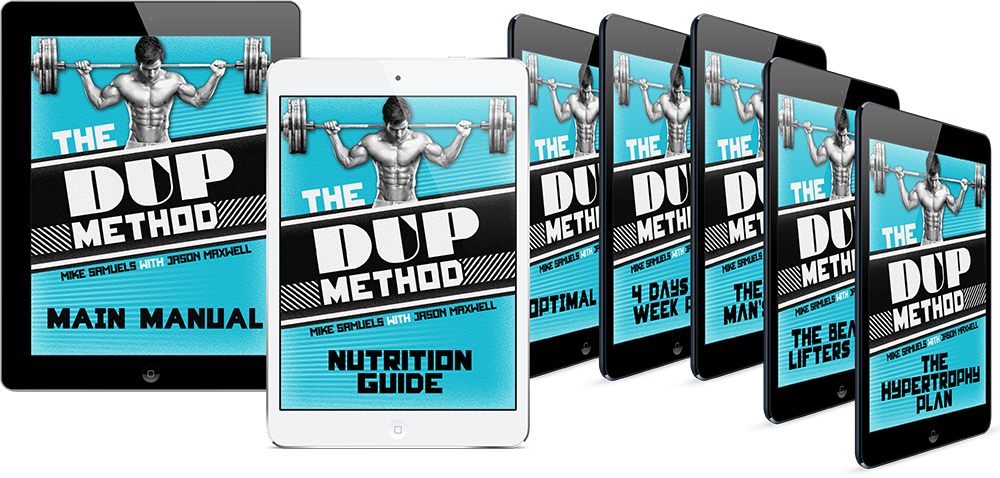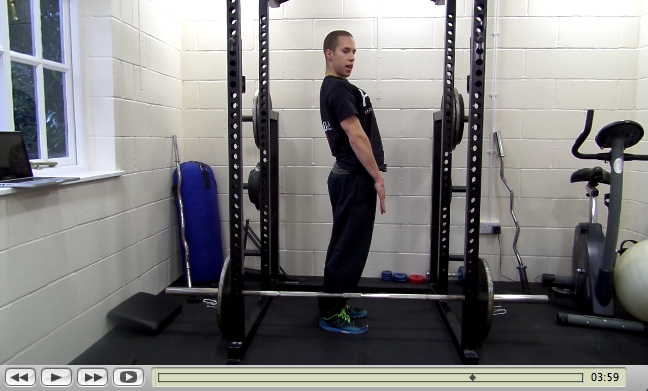 I’ve had an opportunity to check out a new program called The DUP Method (from Jason Maxwell and Mike Samuels). I’ll start this review by explaining what you get if you decide to invest in this program:
I’ve had an opportunity to check out a new program called The DUP Method (from Jason Maxwell and Mike Samuels). I’ll start this review by explaining what you get if you decide to invest in this program:
DUP Method Program Components:
#1 The DUP Main Manual
This document serves as a starting point, explaining the overall training philosophy and science behind the strategies you’ll be using. It will give you an overview of the program as well as some different options for training frequency (anything from 2-5 days). Once you’ve read this you’ll have a basic understanding of why this method should make you stronger.
#2 The DUP Method Nutrition Guide
Needless to say, you can’t get big and strong without a good eating plan. This document will show you how to set up your diet/nutrition in order to maximize the benefits of your training. You’ll be guided in calculating your daily caloric intake as well as macronutrients (fats, proteins, and carbohydrates). Be sure to look over this carefully–many trainees fail to reach their goals because they don’t put much thought or planning into their diet.
#3 The Optimal DUP Workout Log
According to the author, the ideal setup for this program is to train five days per week. That may sound like overtraining, but you have to remember that the volume (number of sets and reps) is adjusted so you’ll be able to adequately recover. Anyway, this workout log is convenient because you can print it out or put it on your smartphone. Either way you could bring it to the gym with you.
#4-Day Per Week Workout Log
As the name implies, this workout is designed for those who can only train four times per week.
#5 The “Busy Man’s” Workout Log
This one is for those who can only train three times a week.
#6 DUP For Beat Up Lifters Workout Log
This is a program variation for lifters who are a little older and/or training around old injuries. Some trainees, for example, may have back issues or joint problems that require them to make some adjustments in their exercise selection, etc. This would be helpful for men (or women) in that situation who want to keep getting stronger while avoiding re-injuring themselves.
#7 DUP For Hypertrophy Workout Log
As the title implies, this program is set up for those who are primarily concerned with building muscle (vs. those who are only interested in strength/powerlifting).
#8 DUP For Fat Loss
Last but not least, these workouts are set up for those who are interested in maximizing fat loss while also benefiting from the strength aspects of the training.
Bonuses:
You’ll also get some nice bonus material if you decide to order.
BONUS #1: Bench Press Tutorial Video
BONUS #2: Squat Tutorial Video
BONUS #3: Deadlift Tutorial Video
BONUS #4: Bigger Bench Checklist
Bonus #5: Customization Guide
Bonus #6: DUP Arms Specialization

I think you’ll find the video tutorials especially helpful. You can watch them online or download them onto your hard drive (I’d recommend downloading them).
Additional Products (Upsells):
Here are additional program packages you can add on to the basic package. You do not have to purchase these, but you can if you are interested:
The Accelerator Package: This includes a manual for diet, training, supplementation and complete workouts for those who want to do an all-out, 6-day per week training schedule.
The Done-for-You Package: This includes spreadsheets for all five of the workouts in the basic package. You just put your one rep max in and it calculates it for you. A nutrition spreadsheet is also included.
The Specialization Package: This includes specialization guides for bench press, deadlift and squat. These programs would be useful for those who really want to focus on improving one of these lifts.
REVIEW:
Have you ever noticed how many guys go to the gym and lift the exact same weight for the same number of reps week in and week out? The reason is pretty simple: they are training like newbies.
Beginner trainees will usually get a little bit stronger every week, regardless of training methodology. But linear progression (adding a little weight to the bar each workout) will only get you so far. You will eventually reach a “sticking point”–a lesson I learned the hard way back in the 90’s.
This is where periodization comes in–training in a way that works with your muscular and neurological system. Daily Undulating Periodization is a unique variation of this strategy that can be very effective.
Keep this in mind: this way of training is not like the typical bodybuilding type split you see in the magazines (and gyms). But I think you’ll find it to be a refreshing change of pace–one that is backed by science. One study, for example, found that the DUP method was superior to linear methods (like 5×5) for building strength in those with significant training experience.1
I believe the DUP Method can teach you how to start making progress again if you find yourself stuck in a rut of no noticeable gains.
*Intermediate to advance trainees who want to break through plateaus in their overall strength. This includes increasing your max in the bench press, squat, and deadlift.
*Athletes who want to increase their strength in order to be more competitive in sports.
*Guys (or girls) who want be strong in addition to looking strong.
*Trainees who are willing to commit to a different style of programming than what they may be used to (especially those who have done a traditional bodybuilding split).
If any of these descriptions fit you then I think the DUP Method would be a worthwhile investment as part of your training library. Just CLICK HERE if you’d like to order this program or learn more. Don’t delay because the price will be going up soon.
Reference:
1. J Strength Cond Res. 2002 May;16(2):250-5. A comparison of linear and daily undulating periodized programs with equated volume and intensity for strength.
